Hollym, Myers Lane, WwTW (2021)
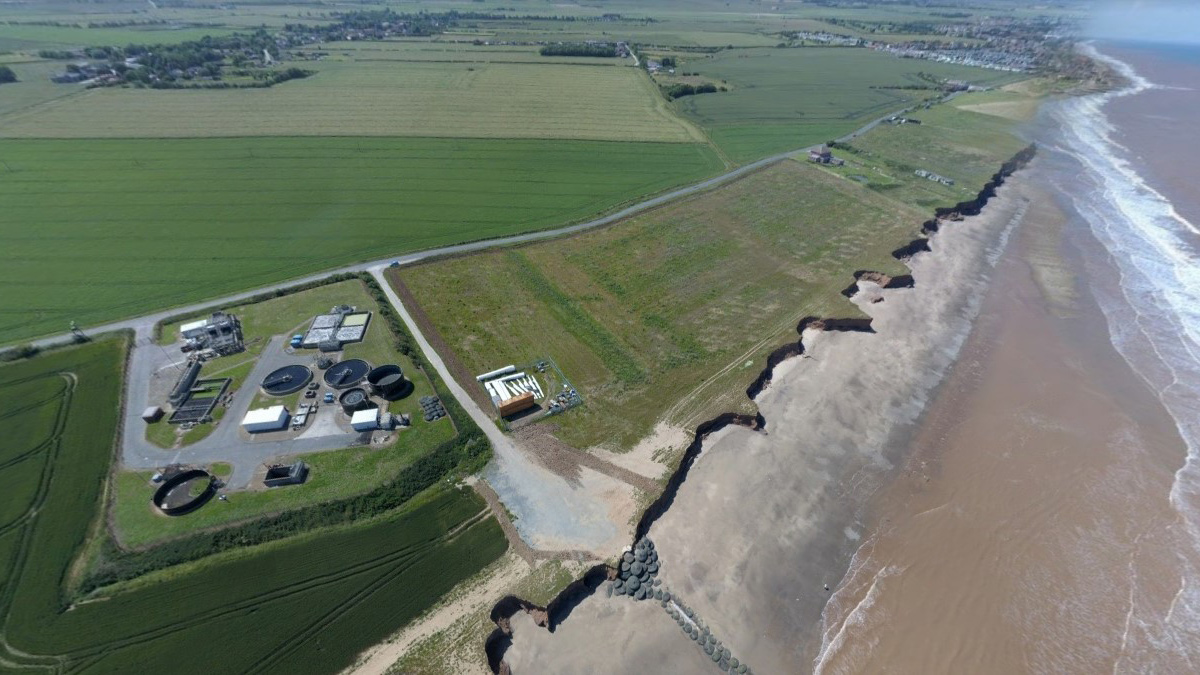
Google image showing the existing Withernsea STW and cliff erosion - Courtesy of Yorkshire Water
Constructed in 1991, the existing Withernsea Sewage Treatment Works (STW) lies 2km south of the East Yorkshire coastal resort town of Withernsea and was built circa 180m from the cliff edge with an expected asset life in excess of 60 years. Since 1998, coastal erosion rates in the area have increased significantly from historic levels, with a current average loss per year of over 4m versus 1m which had previously been recorded. This loss is characterised by large loss events, rather than incremental smaller losses. In December 2017 the site boundary was recorded as 56m from the cliff edge, as of January 2021 this distance was recorded as 44m. Coastal erosion greater than predicted necessitated relocation of the existing sewage treatment works further inland to prevent complete loss of service. A new long sea outfall was also required, and this is covered in a separate case study elsewhere in this publication.
The existing works
Withernsea STW serves a standard winter population of 7,100 and a peak summer population of approximately 15,000. The existing STW comprises a traditional activated sludge plant (ASP), with sludge thickening and UV disinfection. Maximum flow to the works (FtFT plus storm) is 172 l/s. The existing works does not treat storm flows, however the new Hollym, Myers Lane, Wastewater Treatment has been designed to treat all flows.
Following investigation and optioneering works undertaken during AMP6, the decision was made to relocate the treatment works inland south-west of Hollym Village to protect the treatment works from future coastal erosion; situating the new works behind the projected 100-year erosion line.
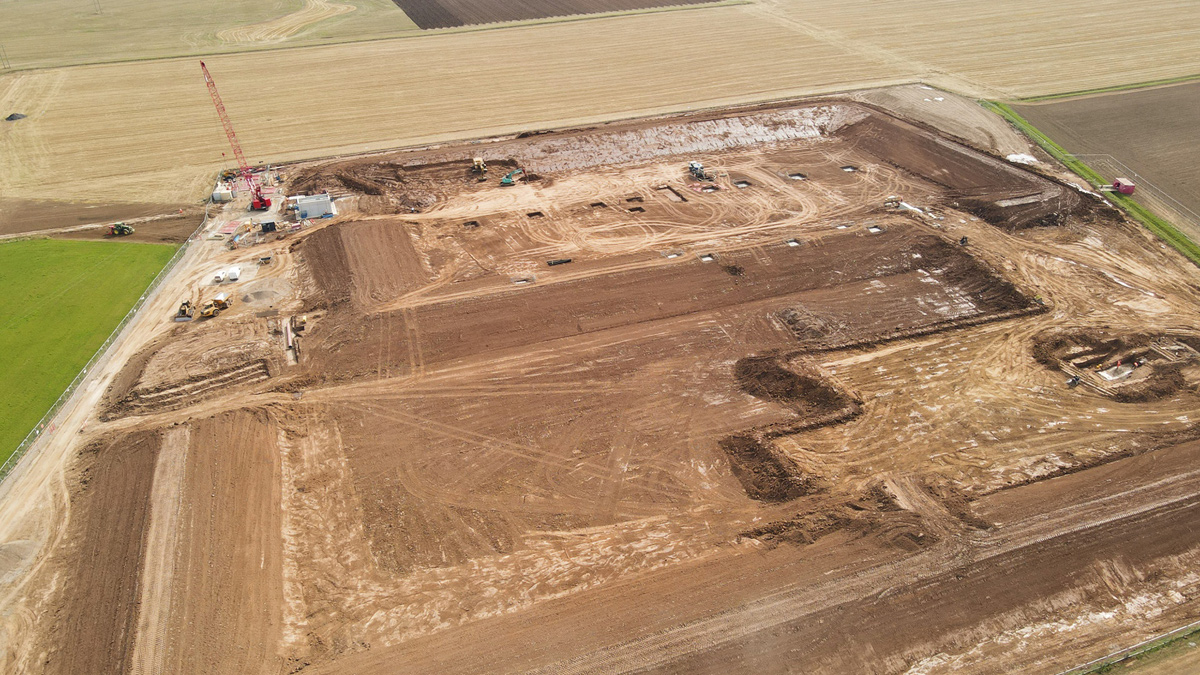
Aerial view of the site September 2020 – Courtesy of Yorkshire Water
Process technology
The outcome of the investigation process, which considered multiple process options, was to adopt Aero-Fac® technology by Gurney Environmental to offer the lowest whole life cost and carbon solution. Though there are a growing number of Aero-Fac® systems in use across the UK, the first having been commissioned for Tayside Regional Council (now Scottish Water) in 2000 at Errol, use of this technology is a first for Yorkshire Water and the Hollym, Myers Lane, site will be the largest of its kind in the UK.
Aero-Fac® is a high-process-rate, modular wastewater treatment system that employs an advanced and optimised form of a completely biological aerated facultative treatment process that automatically adjusts to handle extreme variations in flows and loadings. Given its modular design, it can be scaled and adapted to suit any flow, load, and population size.
By employing a facultative biological process, significant costs can be eliminated in both the initial capital costs (CAPEX) of construction and equipment and the ongoing operating costs (OPEX). Facultative processing can stabilise wastewater more thoroughly than standard mechanical treatment at lower cost and complexity. Advanced methods developed and used by Gurney Environmental in the Aero-Fac® system, enhances the natural facultative biological process’s ability to fully stabilise wastewater while simultaneously self-digesting all incoming sludge.
Using a pure biochemical, natural process with supplemental process enhancing technologies provides:
- A massive aerobic processing section.
- A specialised facultative bacterial zone.
- A full anaerobic sludge digestion section for total 100% on-site treatment.
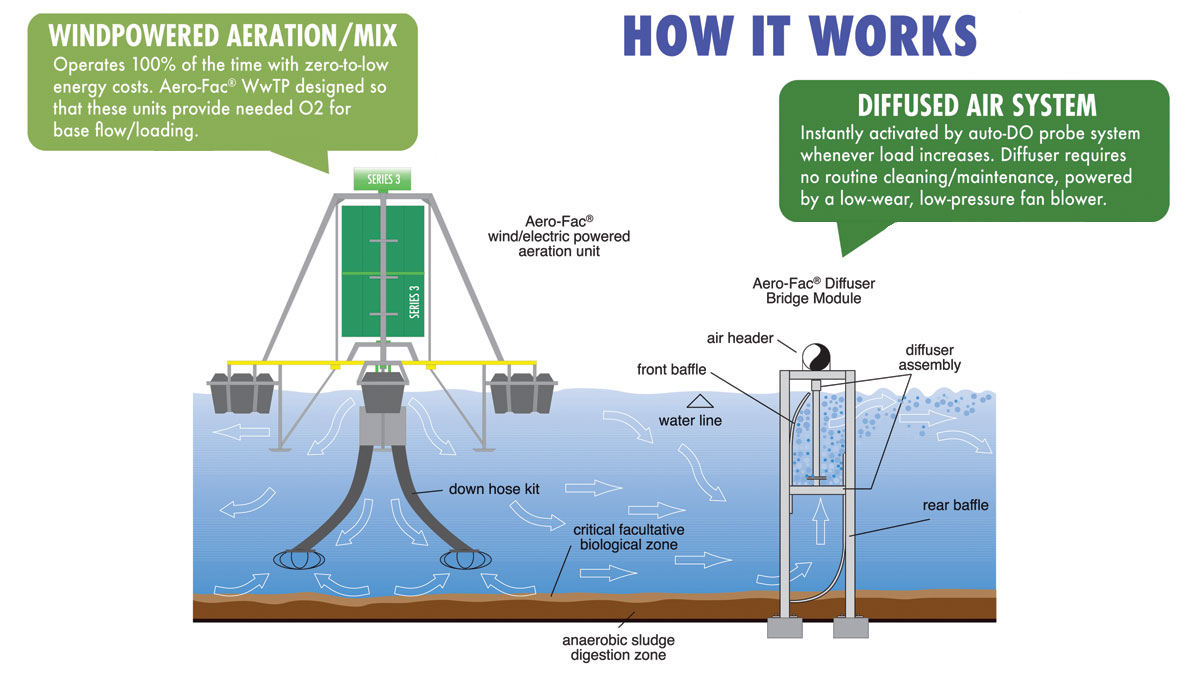
Gurney Aero-Fac® process diagram – Courtesy of Gurney Environmental
The UV system typically required by the Environment Agency was engineered out of the Withernsea WwTW as a result of monitoring carried out by Stantec at other Aero-Fac® wastewater treatment plants in the UK.
Each of the cells at Hollym contains a diffuser module and several SERIES 3 aerator/mixers. The primary cell provides the majority of the treatment process, with 12 (No.) of the 20 (No.) SERIES 3s. The secondary cell contains the remaining 8 (No.) aerator/mixers, as well as a smaller diffuser module to provide effluent ‘polishing’. The new works will operate with only a single outlet screen which is in place to protect the long sea outfall pipe rather than being required of the process itself.
Because of the full anaerobic digestion, use of the Aero-Fac® technology means there is no need for sludge removal on site. This reduces customer impact of the works, as well as providing a significant saving on OPEX and carbon impact. From studies undertaken on other Aero-Fac® sites, there is also no odour issue and subsequently no need for odour control which would typically be required on more conventional sewage treatment works.
Hollym, Myers Lane, WwTW: Supply chain – key participants
- Outline design: Stantec UK
- Principal contractor & designer: Ward & Burke Construction Ltd
- Temporary works: MGF Ltd
- Process design, supply & installation: Gurney Environmental
- Long sea outfall: Van Oord
- Technical documentation: 3rd Light Media
- MCCs & Systems integrator: Lintott Control Systems
- Liner: Geosynthetic Technology Ltd
- Access chambers: Cubis Systems
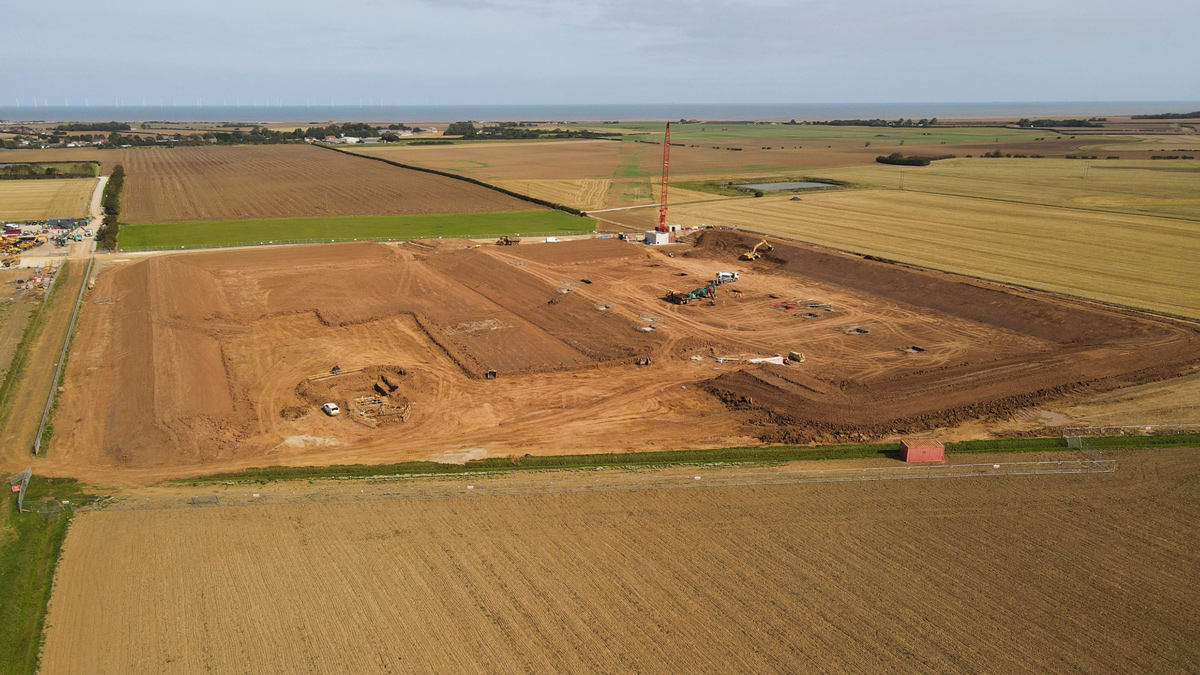
Aerial view of the site October 2020 – Courtesy of Yorkshire Water
Site works
The obvious blocker for implementation of this form of technology would generally be the amount of land required, its availability, and the cost of this. In this case approximately 72,000m2 of land was required to be purchased by Yorkshire Water to locate the new works; an investment that would allow for substantial cost savings both in CAPEX and OPEX.
Withernsea is surrounded by a lot of flat agricultural land. Extensive ground investigation was undertaken to determine the best location for the new site, this proved the geotechnical makeup of the local area to be a consistent boulder clay and Yorkshire Water were able to identify a suitable section for procurement with minimal impact to the local community.
Due to the nature of the ground, a further CAPEX and carbon saving was identified in Gurney Environmental’s outline design, and confirmed by Stantec, which proposed a cut and balance method of construction, with a zero net import/export of material. This was decided on the basis that the as-dug material would be suitable for use in the bund construction to form the embankments, it also minimised the need for removal of material off-site.
The project was awarded to Ward & Burke in June 2020, with mobilisation to site to undertake enabling works by July 2020.
With a combined stored volume of approximately 144,000m3, and an escapable volume of over 25,000m3 per cell, the works falls under the Reservoirs Act 1975. As such, a construction engineer was required to be appointed to oversee and sign-off detailed design and construction of the cells. Stantec was appointed by Yorkshire Water in this capacity. Through collaboration between Ward & Burke, Stantec, and Yorkshire Water, the design and construction plans were approved within a short number of weeks.
Sampling of the existing ground proved the design assumptions on suitability for bund construction to be correct, and a trial embankment was constructed and accepted in July 2020, with a strict testing and monitoring regime implemented to ensure structural quality throughout construction.
Quality and reservoir safety assurance was undertaken throughout construction by Stantec and Yorkshire Water. Construction of the structural bunds was completed by October 2020.
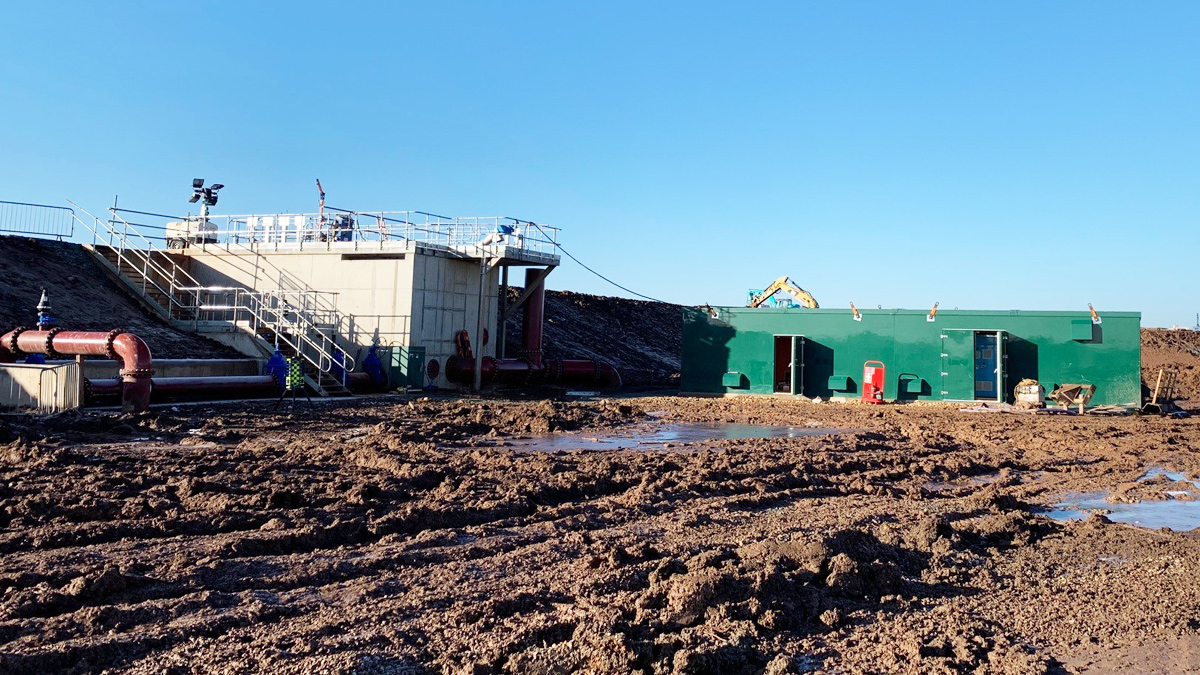
Outlet structure and kiosk – Courtesy of Yorkshire Water
The only significant use of concrete on site has been the outlet structure. The outlet houses the single screen as well as pumps to pass flows down the long sea outfall. The pumps are only required during high tides with flows able to gravitate out under normal circumstances. The site kiosk houses a welfare room for site operatives, as well as the main site MCC.
Site drainage
Another key element of the reservoir design was the site drainage. A system of herringbone underdrains was installed by Ward & Burke which allow for monitoring of flows from inspection chambers and provide the ability to identify any increase in flow that may represent leakage.
This drainage is split by each cell so that any issues can be localised to a half of either of the cells. The underdrain system is supported by toe drainage which can again be monitored in specific inspection chambers to identify any changes in flow. Piezometers situated under the cells and within the embankments provide further monitoring and assurance. These items will form a part of the required inspections and monitoring under the Reservoir Act.
Installation of the Gurney Environmental diffuser module and associated equipment was undertaken in October and November 2020 ahead of liner installation.
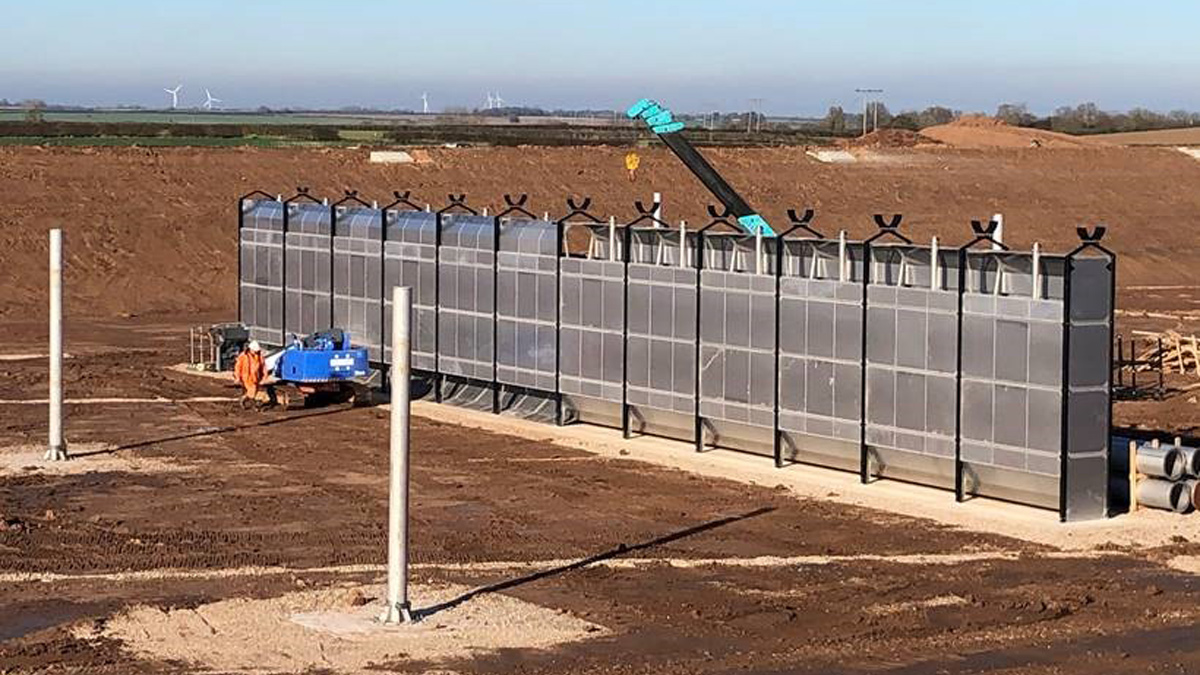
Diffuser installation – Courtesy of Yorkshire Water
Geomembrane liner
The depth of the cells from crest to base is 5.6m, with 1:3 batters internally. A requirement of the design, rather than a reservoir safety requirement, is to have an impermeable geomembrane layer. Through Winter 2020 the geomembrane liner was supplied and installed by Geosynthetic Technology Ltd.
An initial underlay layer is required, followed by the main impermeable sheeting which is then welded together. Adverse weather with subsequently very poor underfoot conditions on site made installation very challenging but this element was completed in January 2021.
Filling the cells
Following final inspections of the work on site by the construction engineer and Yorkshire Water, a preliminary certificate was issued for Cell 1 in January 2021 allowing it to be filled.
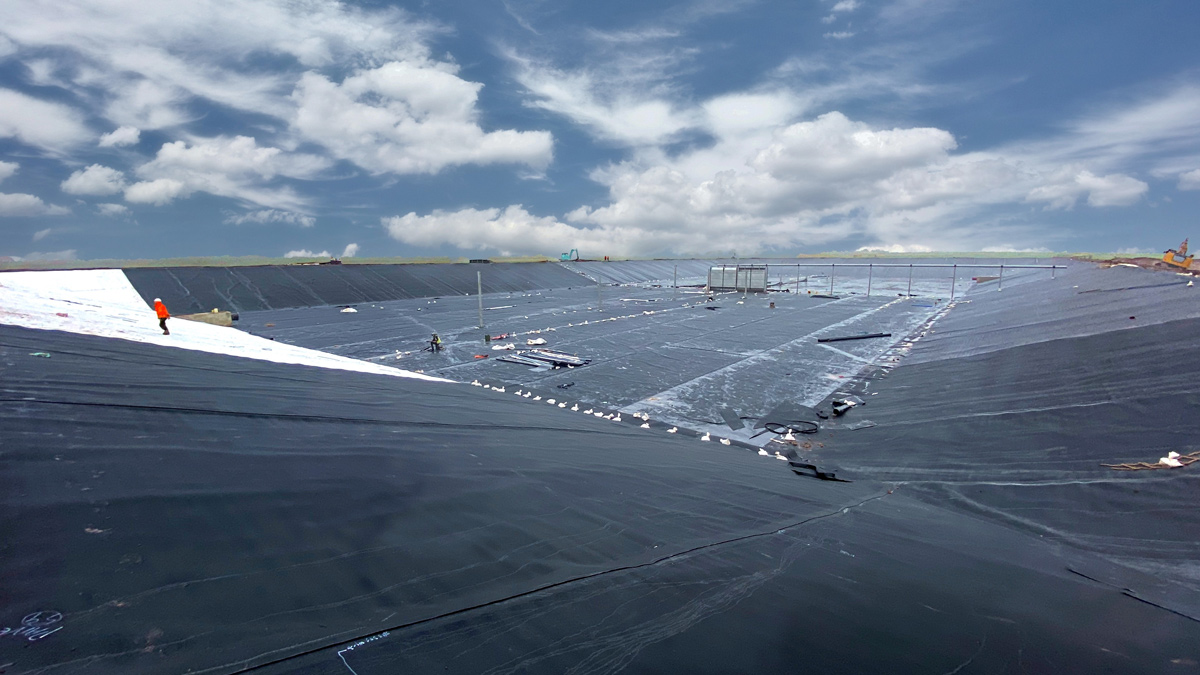
Liner installation December 2020 – Courtesy of Yorkshire Water
Filling of the cells has been undertaken using treated effluent from the existing WwTW, which has been pumped up to the new works along the newly installed rising main. This rising main will be connected to carry crude flows once the site is fully operational and a permit has been agreed and issued by the Environment Agency. Average flows are around 27 l/s and as such filling each cell takes between 6 and 8 weeks. The preliminary certificate for Cell 2 was issued in April 2021, with an expected date of filling to be completed in mid-June.
Remaining programme of work
At the time of writing May 2021, the remaining programme of works includes the installation of the SERIES 3 mixers in late-June, with reliability testing to be undertaken on mechanical and electrical equipment in July 2021.
Process proving will not take place until a permit is implemented by the Environment Agency allowing for discharge from the new WwTW. Once this is in place, the existing works will be decommissioned and demolished by Ward & Burke and the land retained by Yorkshire Water.
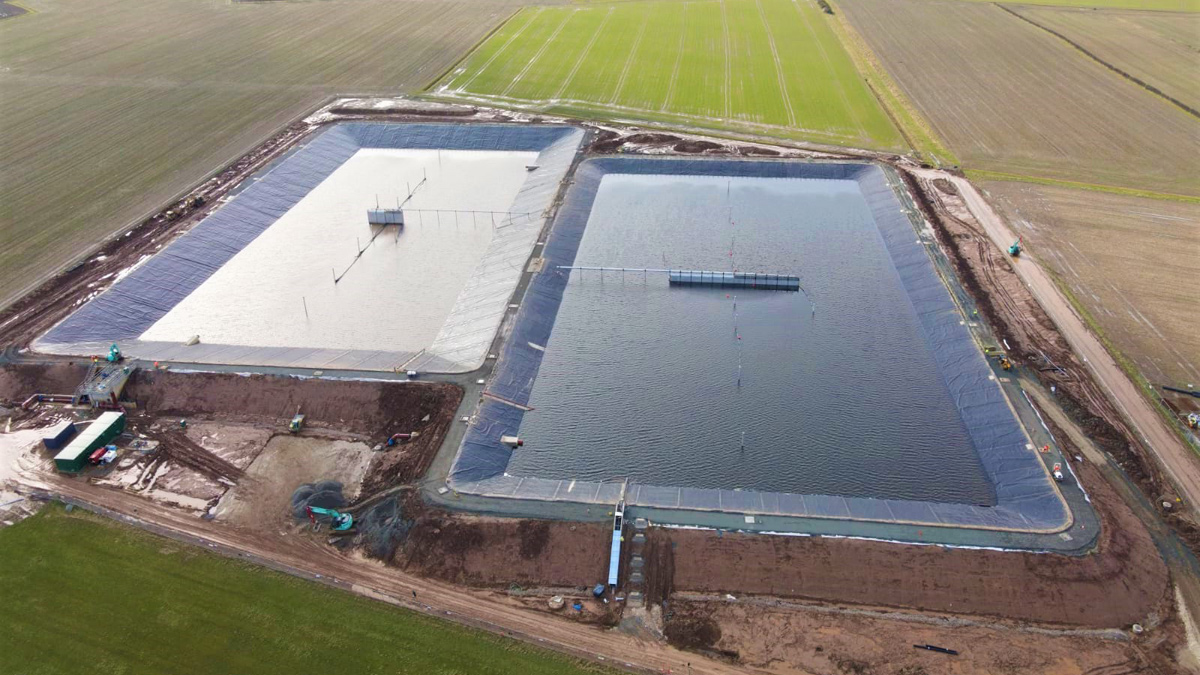
Aerial view of the site March 2021 – Courtesy of Yorkshire Water
Conclusion
The new Aero-Fac® Wastewater Treatment System at Hollym is a first for Yorkshire Water and a dramatic change from conventional sewage treatment. It offers an ultra-low carbon solution when compared with conventional alternatives, greater process resilience, and at a much lower OPEX cost.
This project has been an early adopter of Yorkshire Water’s new ‘Partnership for Yorkshire’ initiative which has a fundamental goal of working collaboratively to provide the best results for all stakeholders.









